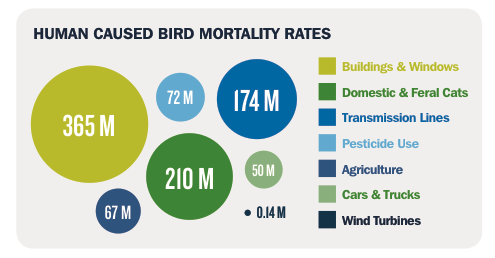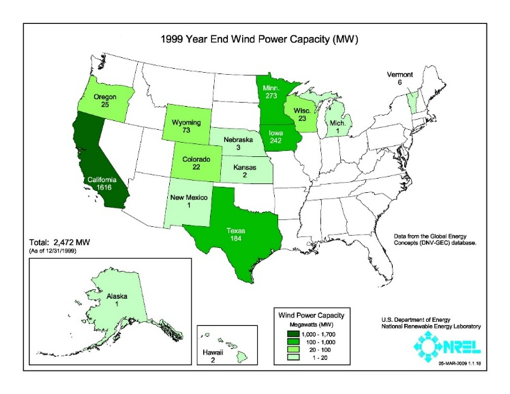FREQUENTLY ASKED QUESTIONS
ABOUT RENEWABLE ENERGY
How does wind energy work?
Wind turbines are simple machines that require no fuel and produce no emissions. They work only when the wind blows past the rotor blades, causing them to turn. The turbine’s blades turn because of “lift”, similar to the way a kite flies. A spin of the rotor blades turns a generator, which then produces electricity. Since a turbine has no motor or power source of its own, it can only turn when it is windy enough. Wind turbines are one of the best renewable ways to become energy independent and reduce pollution. Some wind turbines use a permanent magnet generator rather than a traditional gearbox generator.
What is the total onshore wind capacity in RI?
In 2019, the total capacity of onshore wind turbines installed in Rhode Island totals is just under 42 MW. That’s enough to provide the total energy needs for approximately 7,500 average households, or electricity for approximately 11,000 average households.
How much noise do turbines make?
Wind turbines produce two types of noise: mechanical noise from the gearbox and aerodynamic noise from the blades and cooling system. Because the VENSYS turbine technology used in Green Development turbines is gearless, the only audible sound is the swooshing of the turbine blades and the hum of the cooling fans. The sound of the turbine can only be heard when it is in operation, while a lot of this noise is masked by the sound of the wind blowing through the trees. We generate noise maps for each wind turbine, based on the technology and site-specific characteristics. The wind turbines we develop are sited to meet local noise ordinances.
Reference: Knopper LD, CA Ollson, LC McCallum, Whitfield Aslund ML, RG Berger, K Souweine, and M McDaniel. 2014. “Wind turbines and human health”. Frontiers in Public Health.
What is shadow flicker and how can its impact be minimized?
Shadow flicker is a phenomenon that occurs when the sun is low in the sky, the turbine is located between the sun and an occupied structure, the turbine is facing the sun or the building, and the blades are spinning. When the sun shines through the rotating blades it creates a temporary absence of light each time the blade shadow passes the window inside the structure. During the planning process, Green Development conducts a flicker analysis for every wind turbine to ensure that excessive shadow flicker will not occur. The internationally acceptable amount of shadow flicker is no more than 30 hours per year or 30 minutes per day in an occupied structure.
Is “Wind Turbine Syndrome” real?
Reference: McCunney, R. J., Mundt, K. A., Colby, W. D., Dobie, R., Kaliski, K., & Blais, M. (January 01, 2014). Wind turbines and health: a critical review of the scientific literature. Journal of Occupational and Environmental Medicine / American College of Occupational and Environmental Medicine, 56, 11, 108-30.
How do turbines affect property values?
A University of Rhode Island study was commissioned to analyze the impact of wind turbines on property values. According to the study, “across a wide variety of specifications, the results indicate that wind turbines have no statistically significant impact on house prices. For houses within a half mile of a turbine, the point estimate of price change for properties within ½ mile relative to properties 3-5 miles away 4 is -0.2%. So our best estimate is wind towers have no virtual effect on prices of nearby properties.”
Reference: Lang, C., Opaluch, J. J., & Sfinarolakis, G. (July 01, 2014). The windy city: Property value impacts of wind turbines in an urban setting. Energy Economics, 44, 4, 41Bottom of Form.Top of Form; Hoen, B., Brown, J. P., Jackson, T., Thayer, M. A., Wiser, R., & Cappers, P. (July 15, 2015). Spatial Hedonic Analysis of the Effects of US Wind Energy Facilities on Surrounding Property Values. The Journal of Real Estate Finance and Economics, 51,1, 22-51. Bottom of Form
How do turbines affect wildlife?
Although wind turbines may represent a risk to birds and bats, these figures are small when compared to the number of birds and bats killed due to domestic and feral cats, buildings, and power lines. Green Development works to reduce any potential threat to wildlife through our innovative regrowth projects, which rehabilitate local ecosystems and maintain wildlife. Additionally, wind energy is associated with the lowest number of avian fatalities, as compared to other methods of energy production, including nuclear energy plants and fossil-fuel powered plants.
Reference: Smallwood, K. Shawn. 2013. “Comparing bird and bat fatality-rate estimates among North American wind-energy projects”. Wildlife Society Bulletin. 37 (1): 19-33.; Loss, Scott R, Tom Will, and Peter P Marra. 2012. “Direct human-caused mortality of birds: improving quantification of magnitude and assessment of population impact”. Frontiers in Ecology and the Environment. 10 (7): 357-364.; Wang, Shifeng, Sicong Wang, and Pete Smith. 2015. “Ecological impacts of wind farms on birds/ Questions, hypotheses, and research needs”. Renewable and Sustainable Energy Reviews. 44/ 599-607.; Benjamin K. Sovacool, “Contextualizing Avian Mortality- A Preliminary Appraisal of Bird and Bat Fatalities from Wind, Fossil-Fuel, and Nuclear Electricity,” Energy Policy 37(6) (June, 2009), pp. 2241-2248

Are wind turbines safe?
Yes, design and engineering advances have created an industry where malfunctions and “blade throws” are uncommon and considered a thing of the past. Moreover, specific Setback Guidelines take these uncommon occurrences into consideration, to ensure the safety of the public.
Don't turbines only work on wind farms in Texas and California?
That’s a myth. The viability of a wind turbine is based on 2 factors: the available wind speed and the cost of power. Although the available wind speed in Rhode Island is lower than in other states, the Vensys turbines installed by Green Development utilize a technology that is designed to operate with lower wind speeds. Because Rhode Island has very high electricity prices, even less efficient wind turbines can save money for cities and towns across the state.
What’s the Difference Between Green Development Turbines and Other Turbines?
Green Development utilizes wind turbines manufactured by VENSYS, a German manufacturer. The technology is a direct drive which utilizes a permanent magnet rather than a traditional gearbox to make electricity. Gearboxes are the most common point of failure in wind turbines and create the most noise. A gearless VENSYS wind turbine in the 1.5 MW class contains very few components and requires only 2 liters of motor oil. The turbine produces more electricity because it is available to run 99% of the time due to less wear-and-tear on components and fewer breakdowns. With more than 11,000 turbines installed worldwide, Vensys is the market leader for large wind turbines.
How widespread is Wind Energy?
Installed wind capacity in the United States has grown exponentially from since1999. The graphs below show national wind growth during that period.
www.energy.gov/articles/new-interactive-map-shows-big-potential-america-s-wind-energy-future
Wind Vision Map— expansion of wind energy 2000-2050


What is energy security?
What Policies Support Energy in Rhode Island?
What is a renewable energy standard?
https://nawindpower.com/r-i-legislature-passes-bill-to-boost-renewable-energy-target
https://www.awea.org/MediaCenter/pressreleasev2.aspx?ItemNumber=9004
What is the Renewable Energy Growth (REG) Program?
The REG Program is a performance-based incentive program administered by National Grid and supervised by the Public Utility Commission (PUC). It allows an owner of a renewable energy project to enroll and sell power to National Grid at a fixed rate for 20 years through a tariff. The goal of the program is to promote the installation of grid-connected renewable energy at reasonable costs. The program is designed to help finance the development, construction, and operation of renewable energy distributed-generation projects through tariff-based incentives.
https://energy.gov/savings/renewable-energy-growth-program
What is Net Metering?
Net Metering is a practice whereby the utility acts as a virtual bank for turbine owners. At times when a turbine is producing more power than required, the energy is fed into the grid and the turbine owner receives a credit to use at a later time. The electric grid acts like a battery and the turbine owner’s meter can spin forward and backward. This allows customers to offset the cost of power drawn from the utility and helps reduce the strain on distribution systems.
What is “Remote” or “Virtual” Net Metering?
Remote Net Metering is an extension of Net Metering that allows customers to net meter from sites that are located away from their existing facilities. For example, the Town A purchased three of the wind turbines built in Town B. Town A is able to offset their electricity needs through net metering even though the turbines are located elsewhere.
